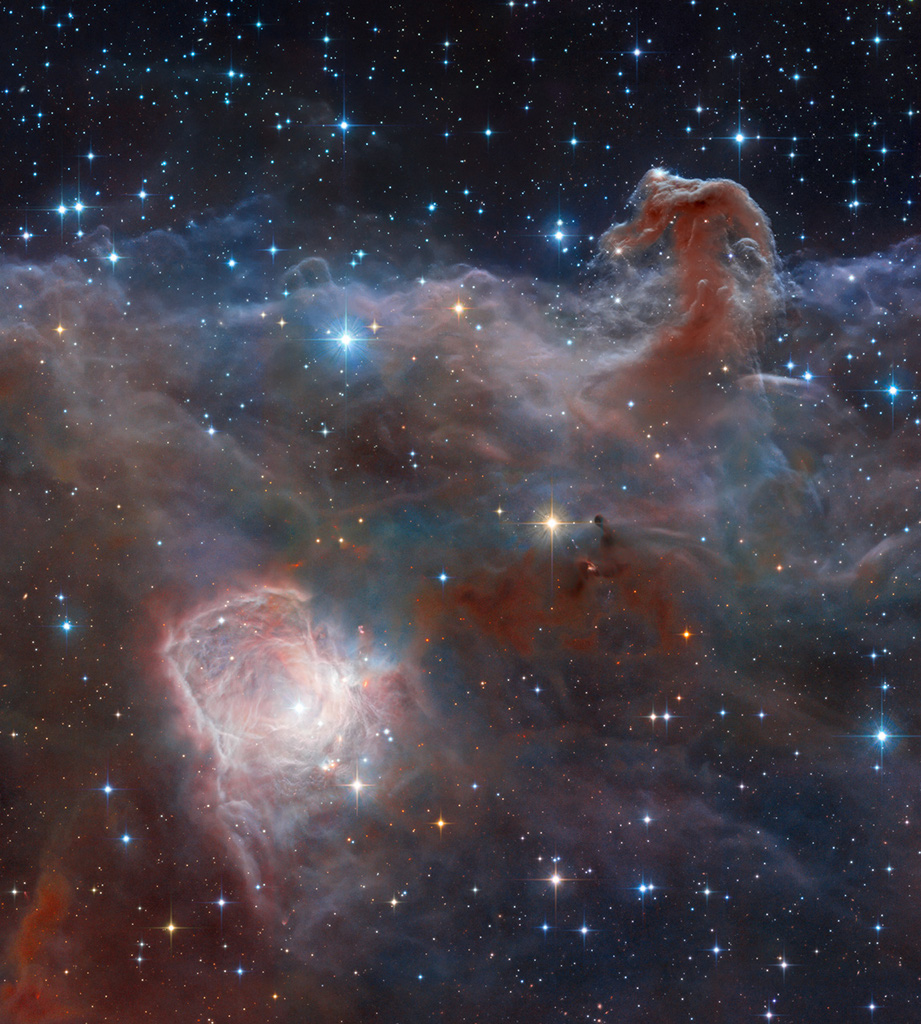
|
| Title: NASA pics | |
| Grapevine50sRoost > ~GENERAL~ > GENERAL DISCUSSION | Go to subcategory: |
| Author | Content |
|
zxxlyzq
|
|
|
Date Posted:09/03/2018 12:10 PMCopy HTML Composition and Processing: Robert Gendler Image Data: ESO, VISTA, HLA, Hubble Heritage Team (STScI/AURA) Explanation: Combined image data from the massive, ground-based VISTA telescope and the Hubble Space Telescope was used to create this wide perspective of the interstellar landscape surrounding the famous Horsehead Nebula. Captured at near-infrared wavelengths, the region's dusty molecular cloud sprawls across the scene that covers an angle about two-thirds the size of the Full Moon on the sky. Left to right the frame spans just over 10 light-years at the Horsehead's estimated distance of 1,600 light-years. Also known as Barnard 33, the still recognizable Horsehead Nebula stands at the upper right, the near-infrared glow of a dusty pillar topped with newborn stars. Below and left, the bright reflection nebula NGC 2023 is itself the illuminated environs of a hot young star. Obscuring clouds below the base of the Horsehead and on the outskirts of NGC 2023 show the tell-tale far red emission of energetic jets, known as Herbig-Haro objects, also associated with newborn stars. |
|
|
Rockymz
|
Share to:





 #121
#121
|
|
Re:NASA pics Date Posted:29/07/2025 8:07 AMCopy HTML Image Credit & Copyright: George Chatzifrantzis Explanation: Is the Helix Nebula looking at you? No, not in any biological sense, but it does look quite like an eye. The Helix Nebula is so named because it also appears that you are looking down the axis of a helix. In actuality, it is now understood to have a surprisingly complex geometry, including radial filaments and extended outer loops. The Helix Nebula (aka NGC 7293) is one of brightest and closest examples of a planetary nebula, a gas cloud created at the end of the life of a Sun-like star. The remnant central stellar core, destined to become a white dwarf star, glows in light so energetic it causes the previously expelled gas to fluoresce. The featured picture, taken in red, green, and blue but highlighted by light emitted primarily by hydrogen was created from 12 hours of exposure through a personal telescope located in Greece. A close-up of the inner edge of the Helix Nebula shows complex gas knots the origin of which are still being researched. |
|
|
Megan57
|
Share to:





 #122
#122
|
|
Re:NASA pics Date Posted:29/07/2025 5:43 AMCopy HTML
|
|
|
Rockymz
|
Share to:





 #123
#123
|
|
Re:NASA pics Date Posted:28/07/2025 8:37 AMCopy HTML
Credit & Copyright: Josh Dury Explanation: Why were the statues on Easter Island built? No one is sure. What is sure is that over 900 large stone statues called moais exist there. The Rapa Nui (Easter Island) moais stand, on average, over twice as tall as a person and have over 200 times as much mass. It is thought that the unusual statues were created about 600 years ago in the images of local leaders of a vibrant and ancient civilization. Rapa Nui has been declared by UNESCO to a World Heritage Site. Pictured here, some of the stone giants were imaged last month under the central band of our Milky Way galaxy. Previously unknown moais are still being discovered. |
|
|
Megan57
|
Share to:





 #124
#124
|
|
Re:NASA pics Date Posted:28/07/2025 6:29 AMCopy HTML
|
|
|
Rockymz
|
Share to:





 #125
#125
|
|
Re:NASA pics Date Posted:27/07/2025 8:38 AMCopy HTML Image Credit: Sergio Montúfar (Pinceladas Nocturnas) Explanation: Have you ever watched a lightning storm in awe? You're not alone. Details of what causes lightning are still being researched, but it is known that inside some clouds, internal updrafts cause collisions between ice and snow that slowly separate charges between cloud tops and bottoms. The rapid electrical discharges that are lightning soon result. Lightning usually takes a jagged course, rapidly heating a thin column of air to about three times the surface temperature of the Sun. The resulting shock wave starts supersonically and decays into the loud sound known as thunder. On average, around the world, about 6,000 lightning bolts occur between clouds and the Earth every minute. Pictured in July 2019 in a two-image composite, lightning stems from communication antennas near the top of Volcán de Agua (Volcano of Water) in Guatemala. |
|
|
Megan57
|
Share to:





 #126
#126
|
|
Re:NASA pics Date Posted:27/07/2025 6:18 AMCopy HTML Amazing Rocky |
|
|
Rockymz
|
Share to:





 #127
#127
|
|
Re:NASA pics Date Posted:26/07/2025 8:39 AMCopy HTML Image Credit & Copyright: Data acquisition - SkyFlux Team, Processing - Leo Shatz Explanation: Globular star cluster Omega Centauri packs about 10 million stars much older than the Sun into a volume some 150 light-years in diameter. Also known as NGC 5139, at a distance of 15,000 light-years it's the largest and brightest of 200 or so known globular clusters that roam the halo of our Milky Way galaxy. Though most star clusters consist of stars with the same age and composition, the enigmatic Omega Cen exhibits the presence of different stellar populations with a spread of ages and chemical abundances. In fact, Omega Cen may be the remnant core of a small galaxy merging with the Milky Way. With a yellowish hue, Omega Centauri's red giant stars are easy to pick out in this sharp telescopic view. A two-decade-long exploration of the dense star cluster with the Hubble Space Telescope has revealed evidence for a massive black hole near the center of Omega Centauri. |
|
|
Megan57
|
Share to:





 #128
#128
|
|
Re:NASA pics Date Posted:26/07/2025 5:55 AMCopy HTML
|
|
|
Rockymz
|
Share to:





 #129
#129
|
|
Re:NASA pics Date Posted:25/07/2025 9:02 AMCopy HTML Image Credit & Copyright: Petr Horálek, Josef Kujal, Tomáš Slovinský; Acknowledgement: Mahdi Zamani Explanation: Meteors from the Kappa Cygnid meteor shower are captured in this time-lapse composite skyscape. The minor meteor shower, with a radiant not far from its eponymous star Kappa Cygni, peaks in mid-August, almost at the same time as the much better-known and better-observed Perseid meteor shower. But, seen to have a peak rate of only about 3 meteors per hour, Kappa Cygnids are vastly outnumbered by the more popular, prolific Perseid shower's meteors that emanate from the heroic constellation Perseus. To capture dozens of Kappa Cygnids, this long term astro-imaging project compiled meteors in exposures selected from over 51 August nights during the years 2012 through 2024. Most of the exposures with identified Kappa Cygnid meteors were made in August 2021, a high point of the shower's known 7-year activity cycle. All twelve years worth of Kappa Cygnids are registered against a base sea and night skyscape of the Milky Way above Elafonisi Beach, Crete, Greece, also recorded in August of 2021. |
|
|
Megan57
|
Share to:





 #130
#130
|
|
Re:NASA pics Date Posted:25/07/2025 5:58 AMCopy HTML Amazing Rocky |
|
|
Rockymz
|
Share to:





 #131
#131
|
|
Re:NASA pics Date Posted:24/07/2025 8:29 AMCopy HTML Image Credit & Copyright: Volodymyr Andrienko Explanation: Every 15 years or so, Saturn's rings are tilted edge-on to our line of sight. As the bright, beautiful ring system grows narrower and fainter it becomes increasingly difficult to see for denizens of planet Earth. But it does provide the opportunity to watch transits of Saturn's moons and their dark shadows across the ringed gas giant's still bright disk. Of course Saturn's largest moon Titan is the easiest to spot in transit. In this telescopic snapshot from July 18, Titan itself is at the upper left, casting a round dark shadow on Saturn's banded cloudtops above the narrow rings. In fact Titan's transit season is in full swing now with shadow transits every 16 days corresponding to the moon's orbital period. Its final shadow transit will be on October 6, though Titan's pale disk will continue to cross in front of Saturn as seen from telescopes on planet Earth every 16 days through January 25, 2026. |
|
|
Megan57
|
Share to:





 #132
#132
|
|
Re:NASA pics Date Posted:24/07/2025 5:58 AMCopy HTML
|
|
|
Rockymz
|
Share to:





 #133
#133
|
|
Re:NASA pics Date Posted:23/07/2025 8:58 AMCopy HTML Image Credit & Copyright: Jason Rice Explanation: Have you ever seen a fireball? In astronomy, a fireball is a very bright meteor -- one at least as bright as Venus and possibly brighter than even a full Moon. Fireballs are rare -- if you see one you are likely to remember it for your whole life. Physically, a fireball is a small rock that originated from an asteroid or comet that typically leaves a fading smoke trail of gas and dust as it shoots through the Earth's atmosphere. It is unlikely that any single large ground strike occurred -- much of the rock likely vaporized as it broke up into many small pieces. The featured picture was captured last week from a deadwood beach in Cape San Blas, Florida, USA. |
|
|
Megan57
|
Share to:





 #134
#134
|
|
Re:NASA pics Date Posted:23/07/2025 6:17 AMCopy HTML Amazing looks like an eye ball |
|
|
Rockymz
|
Share to:





 #135
#135
|
|
Re:NASA pics Date Posted:22/07/2025 8:29 AMCopy HTML Image Credit: ESO, P. Das et al.; Background stars (NASA/Hubble): K. Noll et al. Explanation: Can some supernovas explode twice? Yes, when the first explosion acts like a detonator for the second. This is a leading hypothesis for the cause of supernova remnant (SNR) 0509-67.5. In this two-star system, gravity causes the larger and fluffier star to give up mass to a smaller and denser white dwarf companion. Eventually the white dwarf's near-surface temperature goes so high that it explodes, creating a shock wave that goes both out and in -- and so triggers a full Type Ia supernova near the center. Recent images of the SNR 0509-67.5 system, like the featured image from the Very Large Telescope in Chile, show two shells with radii and compositions consistent with the double detonation hypothesis. This system, SNR 0509-67.5 is also famous for two standing mysteries: why its bright supernova wasn't noted 400 years ago, and why no visible companion star remains. |
|
|
Megan57
|
Share to:





 #136
#136
|
|
Re:NASA pics Date Posted:22/07/2025 6:19 AMCopy HTML Amazing Rocky |
|
|
Rockymz
|
Share to:





 #137
#137
|
|
Re:NASA pics Date Posted:21/07/2025 8:23 AMCopy HTML Image Credit: NASA, ESA, CSA, STScI Explanation: Nebulas are perhaps as famous for being identified with familiar shapes as perhaps cats are for getting into trouble. Still, no known cat could have created the vast Cat's Paw Nebula visible toward the constellation of the Scorpion (Scorpius). At 5,700 light years distant, Cat's Paw is an emission nebula within a larger molecular cloud. Alternatively known as the Bear Claw Nebula and cataloged as NGC 6334, stars nearly ten times the mass of our Sun have been born there in only the past few million years. Pictured here is a recently released image of the Cat's Paw taken in infrared light by the James Webb Space Telescope. This newly detailed view into the nebula helps provide insight for how turbulent molecular clouds turn gas into stars |
|
|
Megan57
|
Share to:





 #138
#138
|
|
Re:NASA pics Date Posted:21/07/2025 6:08 AMCopy HTML Thanks Rocky xi |
|
|
Rockymz
|
Share to:





 #139
#139
|
|
Re:NASA pics Date Posted:20/07/2025 7:22 AMCopy HTML
Image Credit: NASA / GSFC / Arizona State Univ. / Lunar Reconnaissance Orbiter Explanation: About 1,300 images from the Lunar Reconnaissance Orbiter spacecraft's wide angle camera were used to compose this spectacular view of a familiar face - the lunar nearside. But why is there a lunar nearside? The Moon rotates on its axis and orbits the Earth at the same rate, about once every 28 days. Tidally locked in this configuration, the synchronous rotation always keeps one side, the nearside, facing Earth. As a result, featured in remarkable detail in the full resolution mosaic, the smooth, dark, lunar maria (actually lava-flooded impact basins), and rugged highlands, are well-known to earthbound skygazers. To find your favorite mare or large crater, just follow this link or slide your cursor over the picture. The LRO images used to construct the mosaic were recorded over a two week period in December 2010 |
|
|
Megan57
|
Share to:





 #140
#140
|
|
Re:NASA pics Date Posted:20/07/2025 6:31 AMCopy HTML
|
|
|
Rockymz
|
Share to:





 #141
#141
|
|
Re:NASA pics Date Posted:19/07/2025 8:27 AMCopy HTML Image Credit & Copyright: Xinran Li Explanation: The sixth object in Charles Messier's famous catalog of things which are not comets, Messier 6 is a galactic or open star cluster. A gathering of 100 stars or so, all around 100 million years young, M6 lies some 1,600 light-years away toward the central Milky Way in the constellation Scorpius. Also cataloged as NGC 6405, the pretty star cluster's outline suggests its popular moniker, the Butterfly Cluster. Surrounded by diffuse reddish emission from the region's hydrogen gas the cluster's mostly hot and therefore blue stars are near the center of this colorful cosmic snapshot. But the brightest cluster member is a cool K-type giant star. Designated BM Scorpii it shines with a yellow-orange hue, seen near the end of one of the butterfly's antennae. This telescopic field of view spans nearly 2 Full Moons on the sky. That's 25 light-years at the estimated distance of Messier 6. |
|
|
Megan57
|
Share to:





 #142
#142
|
|
Re:NASA pics Date Posted:19/07/2025 7:04 AMCopy HTML Amazing Rocky |
|
|
Rockymz
|
Share to:





 #143
#143
|
|
Re:NASA pics Date Posted:18/07/2025 7:34 AMCopy HTML Image Credit & Copyright: A.J. Smadi Explanation: This month, bright planet Saturn rises in evening skies, its rings oriented nearly edge-on when viewed from planet Earth. And in the early morning hours on July 6, it posed very briefly with the International Space Station when viewed from a location in Federal Way, Washington, USA. This well-planned image, a stack of video frames, captures their momentary conjunction in the same telescopic field of view. With the ISS in low Earth orbit, space station and gas giant planet were separated by almost 1.4 billion kilometers. Their apparent sizes are comparable but the ISS was much brighter than Saturn and the ringed planet's brightness has been increased for visibility in the stacked image. Precise timing and an exact location were needed to capture the ISS/Saturn conjunction. |
|
|
Megan57
|
Share to:





 #144
#144
|
|
Re:NASA pics Date Posted:18/07/2025 5:55 AMCopy HTML
|
|
|
Rockymz
|
Share to:





 #145
#145
|
|
Re:NASA pics Date Posted:17/07/2025 7:26 AMCopy HTML Image Credit: Gemini Observatory/NOIRLab/NSF/AURA/K. Meech (IfA/U. Hawaii) Processing: Jen Miller, Mahdi Zamani (NSF/NOIRLab) Explanation: Discovered on July 1 with the NASA-funded ATLAS (Asteroid Terrestrial-impact Last Alert, System) survey telescope in Rio Hurtado, Chile, 3I/ATLAS is so designated as the third known interstellar object to pass through our Solar System It follows 1I/ʻOumuamua in 2017 and the comet 2I/Borisov in 2019. Also known as C/2025 N1, 3I/ATLAS is clearly a comet, its diffuse cometary coma, a cloud of gas and dust surrounding an icy nucleus, is easily seen in these images from the large Gemini North telescope on Maunakea, Hawai‘i. The left panel tracks the comet as it moves across the sky against fixed background stars in successive exposures. Three different filters were used, shown in red, green, and blue. In the right panel the multiple exposures are registered and combined to form a single image of the comet. The comet's interstellar origin is also clear from its orbit, determined to be an eccentric, highly hyperbolic orbit that does not loop back around the Sun and will return 3I/ATLAS to interstellar space. Not a threat to planet Earth, the inbound interstellar interloper is now within the Jupiter's orbital distance of the Sun, while its closest approach to the Sun will bring it just within the orbital distance of Mars. |
|
|
Megan57
|
Share to:





 #146
#146
|
|
Re:NASA pics Date Posted:17/07/2025 6:02 AMCopy HTML
|
|
|
Rockymz
|
Share to:





 #147
#147
|
|
Re:NASA pics Date Posted:16/07/2025 8:58 AMCopy HTML Image Credit: CTIO, NOIRLab, DOE, NSF, AURA; Processing: T. A. Rector (U. Alaska Anchorage), D. de Martin (NSF’s NOIRLab) & M. Zamani Explanation: Would the Rosette Nebula by any other name look as sweet? The bland New General Catalog designation of NGC 2237 doesn't appear to diminish the appearance of this flowery emission nebula, as captured by the Dark Energy Camera (DECam) on the Blanco 4-meter telescope at the NSF's Cerro Tololo Inter-American Observatory in Chile. Inside the nebula lies an open cluster of bright young stars designated NGC 2244. These stars formed about four million years ago from the nebular material and their stellar winds are clearing a hole in the nebula's center, insulated by a layer of dust and hot gas. Ultraviolet light from the hot cluster stars causes the surrounding nebula to glow. The Rosette Nebula spans about 100 light-years across, lies about 5000 light-years away, and can be seen with a small telescope towards the constellation of the Unicorn (Monoceros). |
|
|
Megan57
|
Share to:





 #148
#148
|
|
Re:NASA pics Date Posted:16/07/2025 6:04 AMCopy HTML That’s def unusual I thought it was a container that had melted |
|
|
Rockymz
|
Share to:





 #149
#149
|
|
Re:NASA pics Date Posted:15/07/2025 7:32 AMCopy HTML Image Credit & License: ESA/DLR/FU Berlin (G. Neukum) Explanation: What's happened in Hebes Chasma on Mars? Hebes Chasma is a depression just north of the enormous Valles Marineris canyon. Since the depression is unconnected to other surface features, it is unclear where the internal material went. Inside Hebes Chasma is Hebes Mensa, a 5 kilometer high mesa that appears to have undergone an unusual partial collapse -- a collapse that might be providing clues. The featured image, taken by ESA's robotic Mars Express spacecraft currently orbiting Mars, shows great details of the chasm and the unusual horseshoe shaped indentation in the central mesa. Material from the mesa appears to have flowed onto the floor of the chasm, while a possible dark layer appears to have pooled like ink on a downslope landing. One hypothesis holds that salty rock composes some lower layers in Hebes Chasma, with the salt dissolving in melted ice flows that drained through holes into an underground aquifer. |
|
|
Megan57
|
Share to:





 #150
#150
|
|
Re:NASA pics Date Posted:15/07/2025 6:01 AMCopy HTML
|































 amazing Rocky
amazing Rocky 